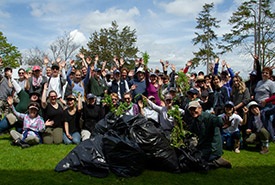Invasive, shrimp-sucking parasite continues northward Pacific expansion

The cough drop-sized parasite Griffen's isopod, native to Asia and Russia, has decimated mud shrimp populations along the West Coast. The parasite on the right is a female with the much smaller male attached. (Florida Museum photo by Amanda Bemis and Gustav Paulay)
By Josh Silberg and Natalie van Hoose Researchers have identified an invasive, blood-sucking parasite on mud shrimp in the waters of British Columbia’s Calvert Island. The discovery represents the northernmost record of the parasite on the...
Tackling invasive European common reed

Me on a six-foot ladder amidst European common reed, to illustrate its height and density. (Photo by Courtney Robichaud)
The highs and lows of monitoring the large-scale suppression of Phragmites australis spp. australis My field crew and I are covered in scratches. I’m a PhD student studying the recovery of native vegetation after invasive species control,...
Murder hornets: What’s all the buzz about?

Asian giant hornets have orange-yellow heads and alternating bands of black, orange and yellow. (Photo by Yasunori Koide, Wikimedia Commons)
If you’ve been following the news this summer, you’re sure to have seen mention of murder hornets. After isolated discoveries of this invasive species in British Columbia and Washington state, news about the Asian giant hornet has...
Could there be an invasive species in your backyard?

Person taking picture of a plant (Photo by iStock)
The changing of the seasons in Canada brings back some of our most beloved species. Migratory birds fly back north, our gardens come alive and buds reappear on the trees. However, the warming weather can also bring some less-than-desirable...
The race against rats: The most successful invasive species in the world

Brown rat (Photo by Dunpharlain, Wikimedia Commons, CC BY-SA 4.0)
Everyone has a rat story, except for, maybe, Albertans (the lucky ones); I’ll explain why in a bit. In Hong Kong, where I grew up, rats and mice were collectively called lo shu in Cantonese. The term was probably tossed around by parents to...
Having a field day

Crane River Tract, ON (Photo by NCC)
This summer, I spent a few days volunteering with the Nature Conservancy of Canada (NCC). My family owns a cottage on the Bruce Peninsula, so we are close to several NCC properties. My dad already knew Esme Batten, NCC’s coordinator of...
Living out my passion for conservation

Brock Hussey (Photo by NCC)
I have always had a passion for nature, like many people in the conservation field. Growing up, I was always outside, surrounded by nature, observing the plants and animals around me. It wasn’t often you would find me without my eyes glued...
Everything you need to know about the threat of grass carp to the Great Lakes

Grass carp (Photo by the Asian Carp Regional Coordinating Committee)
Do you love fishing and boating on the Great Lakes? Are you passionate about the wildlife that live in the Great Lakes? If so, we have an important mission for you: Be on the lookout for grass carp! Grass carp is one of four invasive Asian carp...
Invasive Species Olympics

Phragmites javelin (Photo by NCC)
The Olympic Games: the spectacle of international competition, where every four years, thousands of athletes from over 200 countries compete in the pinnacle of their sport. Inspired by the ancient Olympic Games, first held in Olympia, Greece, in...
A break from the screen: NCC’s 2019 National office field trip

2019 National office field trip participants (Photo by NCC)
On May 24, approximately 70 Nature Conservancy of Canada (NCC) staff from the National office in Toronto, and some who were in town that day, visited our MacMillan Nature Reserve property in Vaughan, Ontario, for our annual staff field trip. The...

